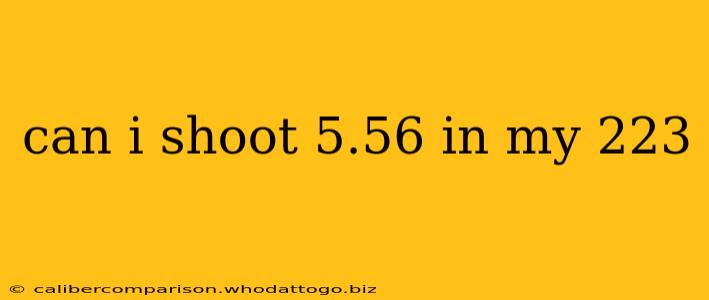Can I Shoot 5.56 in My .223? A Deep Dive into Cartridge Compatibility
The question of whether you can fire 5.56 NATO ammunition in a .223 Remington chamber is a common one, and the short answer is complex: generally yes, but with significant caveats. While seemingly interchangeable, subtle differences between these cartridges can lead to dangerous situations if not fully understood. This article will delve into the specifics, helping you make informed decisions about your firearm's safety and longevity.
Understanding the Differences: 5.56 NATO vs .223 Remington
Both 5.56x45mm NATO and .223 Remington are fundamentally similar in terms of bullet diameter and overall length. However, key distinctions exist in chamber dimensions and pressure:
-
Chamber Pressure: 5.56 NATO rounds are designed to operate at higher chamber pressures than .223 Remington rounds. This difference stems from their intended applications and manufacturing tolerances.
-
Chamber Dimensions: While seemingly minor, variations in chamber dimensions, specifically the leade (the area where the bullet begins its journey down the barrel), can impact safety. .223 Remington chambers are generally tighter, while 5.56 NATO chambers are slightly larger to accommodate the higher pressures.
The Risks of Shooting 5.56 in a .223 Chamber
Firing 5.56 NATO rounds in a .223 Remington chamber carries several risks:
-
Overpressure: The higher pressure generated by 5.56 NATO ammunition in a .223 chamber can cause significant stress on the firearm's components, leading to:
- Barrel Bulge: The barrel can expand and bulge, rendering the firearm unsafe and potentially causing catastrophic failure.
- Case Rupture: The cartridge case can rupture, resulting in injury or death from ejected projectiles and hot gases.
- Action Damage: The receiver and bolt can be damaged, requiring costly repairs or replacements.
-
Accuracy Issues: Even if the firearm doesn't fail catastrophically, the increased pressure can affect accuracy, leading to inconsistent shots and compromised performance.
When It Might Be Safe (With Extreme Caution)
Some manufacturers specifically state their .223 rifles are safe for 5.56 NATO ammunition. However, this should never be assumed. Always consult the firearm's owner's manual. If the manufacturer explicitly states that the firearm is rated for both, you can proceed with extreme caution, but understanding the inherent risks remains crucial.
Best Practices for Safe Cartridge Handling
- Always verify the ammunition type and your firearm's specifications before firing.
- Regularly inspect your firearm for any signs of damage or wear.
- Use only high-quality ammunition from reputable manufacturers.
- Properly clean and maintain your firearm after each use.
- If you're unsure, err on the side of caution and consult a qualified gunsmith or firearms expert.
Conclusion: Proceed with Caution and Prioritize Safety
While the temptation to use readily available 5.56 NATO ammunition in your .223 chamber might exist, prioritizing safety is paramount. Understanding the subtle yet significant differences between these cartridges and adhering to best practices can prevent accidents and ensure the longevity of your firearm. Always consult your firearm’s manual and, when in doubt, seek expert advice. This information is for educational purposes only and does not constitute professional firearms advice.

